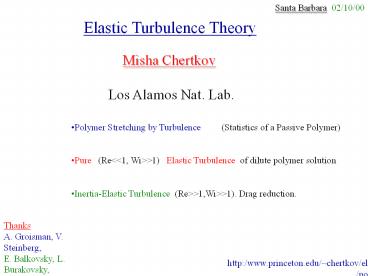Elastic Turbulence Theory - PowerPoint PPT Presentation
Title:
Elastic Turbulence Theory
Description:
Advection Diffusion. Batchelor 59. Kraichnan 68. Shraiman, Siggia 94,'95 ... Statistics of passive scalar advected by the large scale 'Batchelor' velocity ... – PowerPoint PPT presentation
Number of Views:121
Avg rating:3.0/5.0
Title: Elastic Turbulence Theory
1
Santa Barbara 02/10/00
Elastic Turbulence Theory
Misha Chertkov Los Alamos Nat. Lab.
- Polymer Stretching by Turbulence
(Statistics of a Passive Polymer) - Pure (Reltlt1, Wigtgt1) Elastic Turbulence of
dilute polymer solution - Inertia-Elastic Turbulence (Regtgt1,Wigtgt1). Drag
reduction.
Thanks A. Groisman, V. Steinberg, E. Balkovsky,
L. Burakovsky, G. Falkovich, G. Doolen, D.
Preston, S. Tretiak, B. Shraiman
http/www.princeton.edu/chertkov/elturb.tex
/polyprl.tex
2
MC, chao-dyn/9911011 submitted to PRL
Polymer Stretching by Turbulence
Balance of forces
A B C
Models of Elasticity
linear (Hook) dumb-bell
nonlinear chain
nonlinear dumb-bell
smallest scale of the flow
equilibrium polymer length
stretched polymer length
Scale Separation
gtgt
gtgt
The question to describe statistics of passive
polymer ?
Advection gtgt Diffusion
Batchelor 59 Kraichnan 68 Shraiman, Siggia
94,95 MC,Falkovich,Kolokolov,Lebedev
95 MC,Gamba,Kolokolov 94 Balkovsky,MC,Kolokolov,
Lebedev 95 Bernard,Gawedzki,Kupianen98 MC,
Falkovich, Kolokolov 98 Balkovsky,Fouxon 99
Statistics of passive scalar advected by the
large scale Batchelor velocity
is understood
statistics of is given
Passive
3
Passive linear polymer A
CLT for the Lyapunov exponent statistics at
(saddle point parameter)
First order transition the polymer stretches
indefinitly if advection exceeds diffusion
Lumley 72 Balkovsky,Fouxon,Lebedev99
Nonlinearity beats the stretching !!
diss. scale
4
Passive nonlinear polymer B
MC 99
saddle point parameter
Passive nonlinear chain C
- linear conformations are dominant
- N (number of segments) gtgt1 is an
- additional saddle parameter
Notice the nonlinear dependance coming from the
equilibration of the stretching by the
nonlinearity
5
Non-Newtonian hydrodynamics of a dilute
polymer solution
MC, submitted to PRL
Navier-Stokes equation
Scale separation
Hydrod. Inter-polymer
Stretched Equilibrium scales
distance polymer
length polymer length
gtgt
gtgt
gtgt
n- is the polymer solution
concentration Ngtgt1- is the dimensionless
polymer length
Elastic part of the stress tensor in the kinetic
theory approximation
Regime of a weak elasticity (linear stretching)
gtOldroydB model
Regime of a strong elasticity (nonlinear
stretching)gt local relation between
and
Weissenberg number
the maximal tension
the largest eigenvalue of
constitutive equation
the direction of the eigenvector
nondeg.
deg.
6
Pure Elastic Turbulence (experiment)
Groisman, Steinberg 96-99
d20mm
Swirling flow between two parallel disks
d10mm
transition to turbulence
pure solvent
80ppm polyacrylamide 65 sugar1 NaCl in
water
Power spectra of velocity fluctuations
Wi13 Re0.7
7
Pure Elastic Turbulence (theory)
Elastic dissipation gtgt Viscous dissipation,
Advection
Nonlinear diffusion
constitutive equation
poor-man scaling
K- is the pumping amplitude of
8
Inertia-elastic Turbulence (instead of
conclusions)
Energy containing scale
Viscous (Kolmogorov) scale
- Dissipation due to elasticity at the Kolmogorov
scale - is less then the viscous
dissipation - The drag reduction (dissipation dominated by
- the
elasticity onset) - The energy is dissipated at the elastic scale
- Polymers start to overlap each other
- (the kinetic approximation fails)
Increase of n - polymer density
According to Lumley69 the increase in
bulk dissipation (viscosity) is accompanied by a
swelling of a boundary layer, that leads to the
drag reduction































